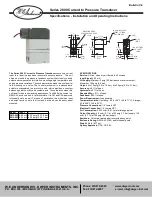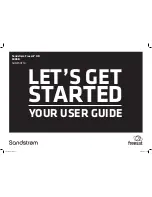
Cable Specifications
Copper cable (
10Base-T/100Base-TX)
Ensure that the correct cable type is installed to support the highest speed and mode of
operation. Though category 3 cable is adequate for a 10Base-T installation, category 5
cable is recommended, since category 3 cable DOES NOT support 100Base-TX.
Category 3:
(minimum requirement for 10 Mb/s operation)
Gauge:
24 to 22 AWG
Attenuation:
11.5 dB/100m @ 5-10 MHz
Maximum cable distance:
100 meters
Category 5:
(minimum requirement for 100 Mb/s operation)
Gauge:
24 to 22 AWG
Attenuation:
22.0 dB /100m @ 100 MHz
Maximum cable distance:
100 meters
• Straight-through (MDI) or crossover (MDI-X) cable may be used.
• Shielded (STP) or unshielded (UTP) twisted-pair cable may be used.
• Pins 1/2 and 3/6 are the two active pairs in an Ethernet network.
• Use only dedicated wire pairs for the active pins:
(e.g., blue/white & white/blue, orange/white & white/orange, etc.)
• Do not use flat or silver satin wire.
10Base-T and the Ethernet collision domain:
•
Refer to the 5-Segment Rule before installing half-duplex 10Base-T
cable.
•
Installing full-duplex twisted-pair cable avoids collision domain
considerations—maximum distance 100 meters.
100Base-TX and the Fast Ethernet collision domain:
•
Refer to the 512-Bit Rule before installing half-duplex 100Base-TX cable.
•
Installing full-duplex twisted-pair cable avoids collision domain
considerations—maximum distance 100 meters.
Note:
A Fast Ethernet collision domain can have only “1” Class “I” repeater or “2”
Class “II” repeaters.
6
MIL-FT240TX
Technical Support: 1.800.466.4526. Press "2" -- International: 1.408.744.2751
Crossover Cable
1
2
3
6
Straight-Through Cable
Twisted Pair #1
Twisted Pair #1
Twisted Pair #2
Twisted Pair #2
1
2
3
6
1
2
3
6
1
2
3
6
Troubleshooting
If the MIL-FT240TX fails or initially does not power up and function properly, ask the
following questions and take the suggested corrective actions.
1.
Is the power LED on the transceiver ON?
NO:
a.
Is the barrel connector from the external power supply fully inserted into
the transceiver?
b.
Is the adapter plugged into an external power source?
c.
Contact Technical Support: 1.800.466.4526, then press "2."
YES:
Go to step 2.
2.
Is there an active
(connected to an output source)
RJ-45 cable inserted into the
transceiver main port?
NO:
a.
Insert an RJ-45 cable into the transceiver main port
b.
Insert the other cable end into an active device
YES: Go to step 3.
3.
Is the link/active LED on the main port lit (ON)?
NO:
a.
Check that the RJ-45 cable is properly inserted into the transceiver main
port.
b.
Check that the other cable end is inserted into an active device
c.
Check the cable for damage
d.
Contact Technical Support
YES:
Go to step 4.
4.
Is there an RJ-45 cable inserted into the primary port on the transceiver?
NO:
a.
Insert the RJ-45 cable into the transceiver primary port
b.
Insert the other end of the cable into the input of an active device
YES:
Go to step 5.
5.
Is the primary LED on the chassis lit (ON)?
NO:
a.
Check that the RJ-45 cable is properly inserted into the primary port
b.
Check that the other end of the cable is properly inserted into an active
device
c.
Check the cable for damage
d.
Contact Technical Support
YES:
Go to step 6.
7
MIL-FT240TX
Email: [email protected]

























